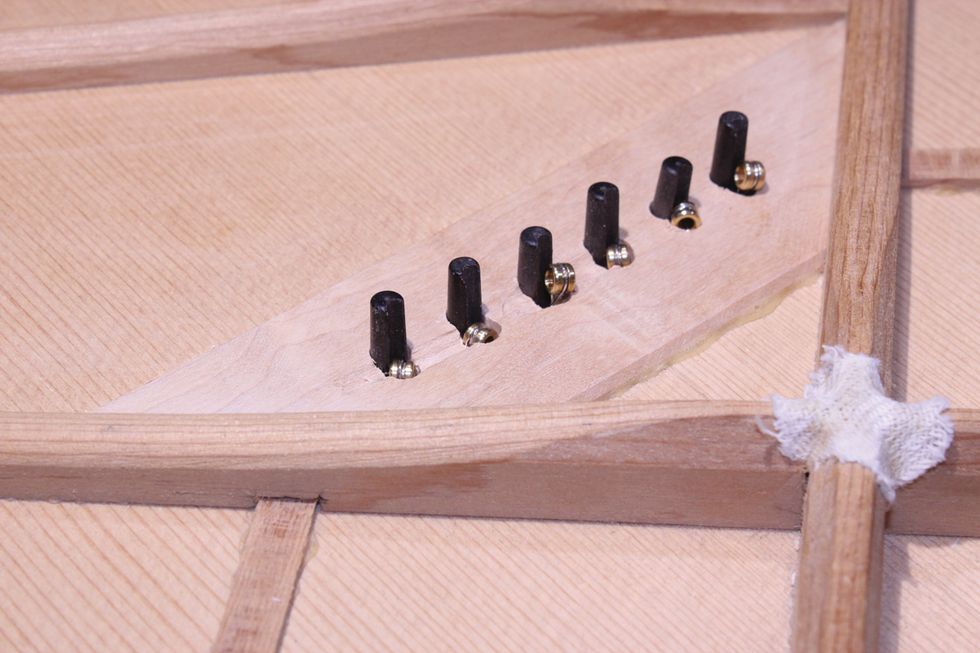It’s no secret that the soundboard is the key element for quality tone on an acoustic instrument. However, components attached to the soundboard, such as bridge material, bridge-plate material, and brace stock, will enhance or dampen an instrument’s performance as well. Through the balance of these secondary components, luthiers control the instrument’s voice. So it stands to reason that these items must also be of the highest quality and used correctly for the best possible outcome.
In the coupled system of an acoustic guitar top, the ratio of weight to strength is the result of the combined collaboration of all of its parts. For the style of sound a luthier is shooting for, there is an ideal balance for desired tone and response. The weight or strength is going to be either in the top or the braces, and borne in the bridge or bridge plate.
Let’s say the maker wants to use X-braces and scallop them to recreate a classic, vintage tone. Luthiers have to select an appropriate soundboard to collaborate with the scalloping process—the same goes for other bracing patterns and voicing styles—so they can mold the instrument’s tone for different players to achieve their ideal sound.
Early nylon-string instruments had thinner tops and lighter bracing, since they could accommodate the lower tension of nylon strings. These instruments used a pinless bridge, and their bridge plates were most commonly made of spruce and were fairly small. Once higher-tension steel strings were introduced, this meant soundboards had to be thicker, bracing had to be beefed up, and bracing patterns moved from fan bracing to the modern-X style. Additionally, bridge-plate materials shifted to harder woods, such as maple or rosewood, to accommodate the pinned-style bridges that anchor the ball ends to the bridge plate (Photo 1).
Somewhere between 1920 and 1945, steel string guitar makers hit their ideal stride by balancing top thickness, brace voicing, the bridge, and bridge-plate size to form the tone of some of the world’s most iconic instruments. By the early 1960s, the popularity of steel-string guitars grew exponentially due to the folk-music boom. In an attempt to keep up with the high demand, however, material quality was compromised as manufacturers started using weaker, heavier tops.
Soundboard failures soon followed, so bracing and bridge-plate sizes were then increased in an attempt to stabilize the lower-quality soundboards. But because the overall weight of the tops increased and stiffness decreased, these moves compromised the instruments’ stability and lowered the quality of the tone and response.
Bridge-plate sizes, for example, shifted from small, vintage-style footprints and thinner profiles to a footprint that was twice the size and double the thickness. By the 1970s, some makers moved to plywood bridge plates in an attempt to remedy some instruments’ structural issues. Unfortunately, the addition of a large, thick bridge plate to make up for poor material choices was an ill-advised move. It only dampened the instruments’ performance as they continued to routinely fail.
Photo 2
When tuned to pitch and operating correctly, a bridge pin’s job is to hold the ball end in place under the bridge plate. When it’s not operating correctly, the ball end is allowed to sink into the bridge plate (Photo 2), which will distort the bridge pin and cause a number of woes, such as tuning issues and tonal distortion. Not surprisingly, when lower-quality bridge-plate materials were introduced, we started seeing an increase in this type of failure, which eventually needs repair or replacement. It’s a very advanced repair, and if not performed correctly it can severely damage a guitar’s soundboard.
Fortunately, our industry has revisited the quality craftsmanship that produced those iconic vintage guitars, spearheaded in part by luthiers such as Bill Collings, who practiced time-tested building approaches using quality materials. This allows luthiers to once again focus on smaller, lighter components that significantly increase an instrument’s response, as they are significantly better positioned to withstand string tension and humidity fluctuations. From a repairperson’s standpoint, focusing on the maintenance of high-quality, great-sounding guitars is much more rewarding work than major restorations to stabilize failing instruments.




















